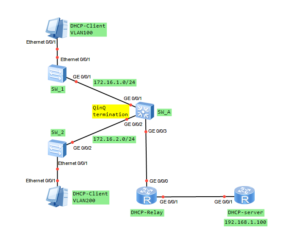If you, for some reason, cannot use easy-ip NAT, you can use source NAT with NAT address pool. Depending on how many public IP addresses you have got, you can configure no-PAT option, when only IP address is translated or you can set PAT, in other words NAT with port translation to assure LAN users accessing Internet. Details in the video 😉
USG firewall configuration script:
#
dhcp enable
#
interface GigabitEthernet1/0/0
undo shutdown
ip address 10.0.0.1 255.255.255.0
service-manage ping permit
dhcp select interface
dhcp server excluded-ip-address 10.0.0.100
dhcp server static-bind ip-address 10.0.0.200 mac-address 5489-98b4-6a79
dhcp server dns-list 10.0.0.100
#
interface GigabitEthernet1/0/2
undo shutdown
ip address 5.0.0.2 255.255.255.252
#
firewall zone trust
set priority 85
add interface GigabitEthernet1/0/0
#
firewall zone untrust
set priority 5
add interface GigabitEthernet1/0/2
#
ip route-static 0.0.0.0 0.0.0.0 5.0.0.1
#
nat address-group SOURCE-NAT 0
mode pat
route enable
section 0 6.6.6.0 6.6.6.0
OR
nat address-group SOURCE-NAT 0
mode no-pat global
route enable
section 0 6.6.6.0 6.6.6.1
#
security-policy
rule name ALLOW
source-zone local
destination-zone trust
destination-zone untrust
action permit
rule name NAT_EASY
source-zone trust
destination-zone untrust
source-address 10.0.0.0 mask 255.255.255.0
action permit
#
nat-policy
rule name SOURCE-NAT
source-zone trust
destination-zone untrust
source-address 10.0.0.0 mask 255.255.255.0
action source-nat address-group SOURCE-NAT
 Labnario Huawei From Scratch
Labnario Huawei From Scratch

